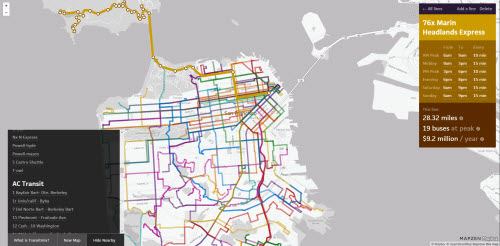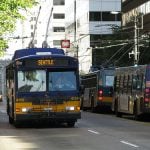SimCity for pros? Transitmix fosters fantasy transportation
You’ve heard of fantasy football. But for urban planning junkies like ourselves, what could be more thrill-inducing than fantasy transportation? A new mapping tool, Transitmix, provides exactly that. Particularly useful for urban planners – but open to all transport aficionados — Transitmix allows users to create bus routes across certain cities by clicking on different points and dragging a dream path into being. It also lets users set schedules and estimate labor-exclusive operating costs.

Boss not at work for a few days? Got a few low-productivity hours to spend, and a beef with your local transit authority? We highly recommend Transitmix as a timesink. From transitmix.com.
Created by Code for America, a San Francisco nonprofit that develops open source technology and helps make government services “simple, effective, and easy to use,” Transitmix draws its roots from a “hackathon” earlier this year, and from Streetmix, another planning tool also designed by Code of America. (Streetmix is an interactive street-builder tool that lets users design and share street mockups with city planners.)
As Tiffany Chu, one of five of the system’s developers, explains to Co.Exist, “It lets anyone sketch a transit line and see the trade-offs between service, scheduling, and cost, and then be able to share with the public.” The routing is imagined, but the data that powers the tool is real. Try it for yourself: Begin by choosing your city; then drag and drop markers along the streets to create the would-be route. Modify other factors — for example, rush hour timing — to determine how many buses would be necessary during peak hours, and rely on real-life ridership figures and operating cost estimates.
Users can peruse others’ maps, too: Check out the 231-line route in San Francisco, for example, outfitted with nearly 5,000 miles of coverage and 3,380 buses during peak hours. Then there’s a Detroit plan, with 106 lines, 335 peak-hour buses, and a cost of $165 million annually, and a Bangkok map offering 4,731 peak buses and clocking in at $595 million in operating costs.
Transitmix — while entertaining for the amateur planner and, as Chu says, intended to “democratize city planning” — is perhaps most useful for filling in the gaps for transit planning departments, many of which lack bus routing tools. These instead often use a patchwork combination of markers, transparent paper, Google Maps, and map printouts, as well as Microsoft Excel for calculating costs, reports Co.Exist. “We discovered what we had designed, which was kind of a fun tool, really turned out to fill this niche in the workflow of transit planners everywhere,” Chu says.
The tool was beta-launched in June and, since then, both pro and would-be planners have relied on it to create more than 40,000 new transit maps and 125,000 bus lines across 3,600 cities worldwide. Next steps for the popular tool include a professional version, called TransitmixPro, and, potentially, an outreach version for assisting cities in sharing bus route plans and route changes with the public.
Want to learn more? Check out Code for America’s minute-long introduction video, available here.
Related Posts
Category: Transportation

















